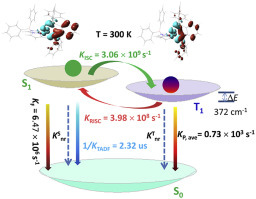Organic Electronics ( IF 2.7 ) Pub Date : 2017-09-15 , DOI: 10.1016/j.orgel.2017.09.017 LingLing Lv , Kun Yuan , YongCheng Wang

|
The photophysical properties of a mononuclear Cu(dppb)(pz2Bph2) complex have been investigated by employing the thermal vibration correlation function (TVCF) approach. The harmonic oscillator model with origin displacement, distortion, and Duschinsky rotation effects for the potential energy surfaces are considered. Absorption spectrum obtained by the scalar relativistic density functional theory combined with restricted open-shell configuration interaction including spin-orbit coupling effects is in excellent agreement with the experimental data. We found that the intersystem crossing (ISC) from the first excited singlet state (S1) to the triplet state (T1) is forbidden by direct spin-orbit coupling at the first-order perturbation, but becomes allowed through combined with vibronic coupling. The reverse intersystem crossing (RISC) proceeds at a rate of KRISC = 3.98 × 108 s−1 at room temperature 300 K, which is about 6 order of magnitude larger than the mean phosphorescence rate, KP, av = 7.3 × 102 s−1. At the same time, the ISC rate KISC = 3.06 × 109 s−1 is again about 3 order of magnitude larger than the fluorescence rate KF = 6.47 × 106 s−1. This implies that the S1 state can be populated from the T1 state, TADF should be observed and TADF decay time is τ(300 K) = 2.32 μs by fitting calculation. But at 30 K, the situation will change. The RISC rate becomes very small, about KRISC = 1.19 × 101 s−1, while the ISC rate only decreases slightly from KISC = 3.06 × 109 s−1 to KISC = 1.93 × 109 s−1. As a consequence, the Cu(dppb)(pz2Bph2) complex is highly attractive candidates for applications of TADF.
中文翻译:

热活化延迟荧光铜(I)配合物的基本光物理过程的理论研究:逆系统间交叉和辐射速率常数的确定
已通过采用热振动相关函数(TVCF)方法研究了单核Cu(dppb )(pz 2 Bph 2)配合物的光物理性质。考虑具有势能面的原点位移,畸变和Duschinsky旋转效应的谐波振荡器模型。通过标量相对论密度泛函理论结合受限的开壳构型相互作用(包括自旋轨道耦合效应)获得的吸收光谱与实验数据非常吻合。我们发现从第一个激发单重态(S 1)到三重态(T 1)的系统间穿越(ISC))在一级扰动下被直接自旋轨道耦合所禁止,但通过与振动耦合相结合而被允许。 在室温300 K下,反向系统间交叉(RISC)的速率为K RISC = 3.98×10 8 s -1,比平均磷光速率K P大约大6个数量级,av = 7.3×10 2 s -1。同时,ISC率K ISC = 3.06×10 9 s -1再次比荧光率K F = 6.47×10 6 s -1大3个数量级。。这意味着可以从T 1状态填充S 1状态,应观察TADF,并且通过拟合计算,TADF衰减时间为τ(300 K)= 2.32μs 。但是在30 K时,情况将会改变。RISC速率变得非常小,大约为K RISC = 1.19×10 1 s -1,而ISC速率仅从K ISC = 3.06×10 9 s -1略微降低到K ISC = 1.93×10 9 s -1。结果,Cu(dppb )(pz 2 Bph 2)复合物是TADF应用程序的极具吸引力的候选人。











































 京公网安备 11010802027423号
京公网安备 11010802027423号